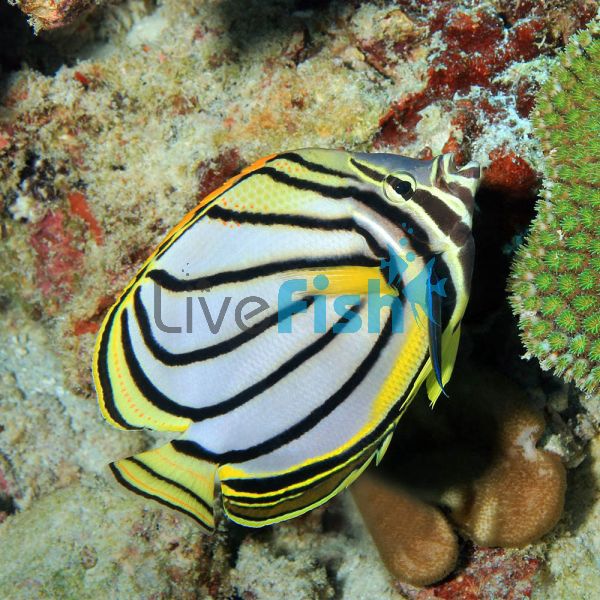Butterflyfish Scrawled - Medium
The Scrawled Butterflyfish is a must-have for any discerning fish tank owner. Its tiger-like black stripes pop off their bright yellow backdrop to make them a real focal centrepiece to your aquarium.
The Scrawled Butterflyfish has a slightly off-white body with curving and diagonal black bars on its flanks that bend backwards. A black bar with a yellow edge goes through the eye, and a similar bar runs around the mouth and nose. The dorsal fin of this species contains 12-13 spines and 23-25 soft rays, while the anal fin has three spines and 18-20 soft rays. It can grow up to 20 cm in length (7.9 in).
Butterflyfish, in general can be difficult to keep, mainly due to their natural food source being coral polyps. So some previous experience is recommended, but they can thrive on aiptasia.
They are found in tropical waters of the indo-pacific region North to South from the Ryuku Islands to the Great Barrier Reef and East to West from East Africa to the Line Islands.
Tank Recommendations for Scrawled Butterflyfish
The smallest tank size for this fish is 500 Litres, as they need space to swim.
Live corals are essential as this species survives almost exclusively on coral polyps. Extensive destruction of corals will be experienced unless a food substitute is accepted. This is not always guaranteed.
Many of these species can be difficult to persuade to eat at first, but they can't resist live zooplankton or live mussels with smashed shells. Another approach is to pack their food into coral bones or stones to replicate their natural behavior.
This species enjoys swimming, so a large, long tank is recommend.
Live rocks should be in situ as this fish likes to hide in crevasses and cracks.
Suitable Tank Buddies
These fish are normally docile and ignore most other fish, so groups Butterflyfish will get along swimmingly. They are also compatible with Angelfish, Boxfish, Clownfish, and other non-aggressive species. Butterflyfish are one of the most versatile fish when it comes to compatibility. On the flip side though, they are difficult to keep in normal aquarium settings due to their eating habits.
Usually Compatible
You can usually keep a mated pair together, but they may become aggressive to another of the same species not part of the mated pair. This can be avoided if the tank is large enough for them to have their own territory.
Sometime Compatible
They sometimes eat crustaceans in the wild, so an ample alternative food source is recommended if you have these in your tank. Other than that, they are sometimes compatible with Rays and Eels, but a large tank is recommended if these species are together in the same tank.
Rarely Compatible
You should not have slow-moving species like seahorses in the same tank as butterflyfish as they are competing for the same food source. It's also wise to avoid Sharks as they will see the butterflyfish as a tasty snack. Corals should be avoided unless you have an expansive collection, and are willing to replace them. Otherwise they will very quickly become depleted if they are in short supply.
Feeding your Scrawled Butterflyfish
Their natural food source is coral polyps, so unless you have an extensive collection over a large tank, or you can afford to replace them. If you don't want to have corals as their main food source, then mixing them with coral is not recommended. They also feed on invertebrates and crustaceans, so these can be a good option. It is recommended to stuff these into coral bones to replicate their natural feeding habits.
| Scientific Name | Chaetodon meyeri |
|---|---|
| Care Level | Hard |
| Common Names | The Scrawled Butterflyfish, is also known as the Meyer's butterflyfish and the Meyer's coralfish |
| Diet | Omnivore |
| Fish Family | Chaetodontidae |
| Lifespan (years) | 6 |
| Max. Length (cm) | 20 |
| Min. Tank Volume (l) | 500 |
| Origin | Indo-Pacific |
| Reef Safe | No |
| Sociability | Peaceful |
| Venomous | No |
| Water Conditions | 22.8-27.8° C (73-82° F), dKH 8-12, pH 8.2-8.4, sg 1.020-1.025 |




